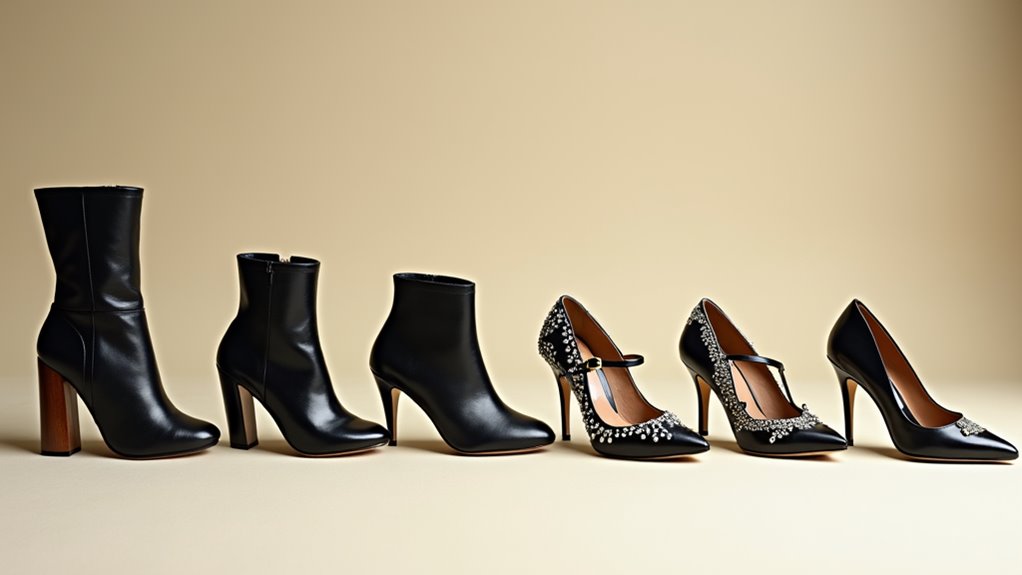There may be products. Products are independently selected by our editors. We may earn an affiliate commission from the links with no charge to you, example: as Amazon Affiliate.
In the 1920s, we saw women’s footwear undergo a dramatic transformation from practical Victorian boots to glamorous fashion statements. The decade introduced innovative heel designs like T-straps, Cuban heels, and Louis heels, typically around 2 inches high, perfect for the era’s energetic dances like the Charleston. Mass production made these stylish options more accessible, while Art Deco influences brought geometric patterns and decorative elements like sequins and beads. Evening shoes sparkled with satin finishes and intricate embroidery, reflecting women’s growing independence and self-expression. The evolution of 1920s heels marked a pivotal moment that would shape fashion’s relationship with femininity for generations to come.
Key Takeaways
- Heel designs evolved from pointed toes to rounded almond and square shapes, with 2-inch pumps becoming a popular standard height.
- T-straps and lattice constructions merged functionality with glamour, while decorative elements like sequins made shoes both practical and fashionable.
- Dance culture influenced heel design, leading to comfortable Cuban and Louis heels that supported energetic movements like the Charleston.
- Mass production methods improved quality and accessibility, making stylish footwear available to working women across social classes.
- Art Deco influences brought geometric patterns and contrasting leather combinations, transforming heels into expressions of personal style.
The Rise of Visible Footwear
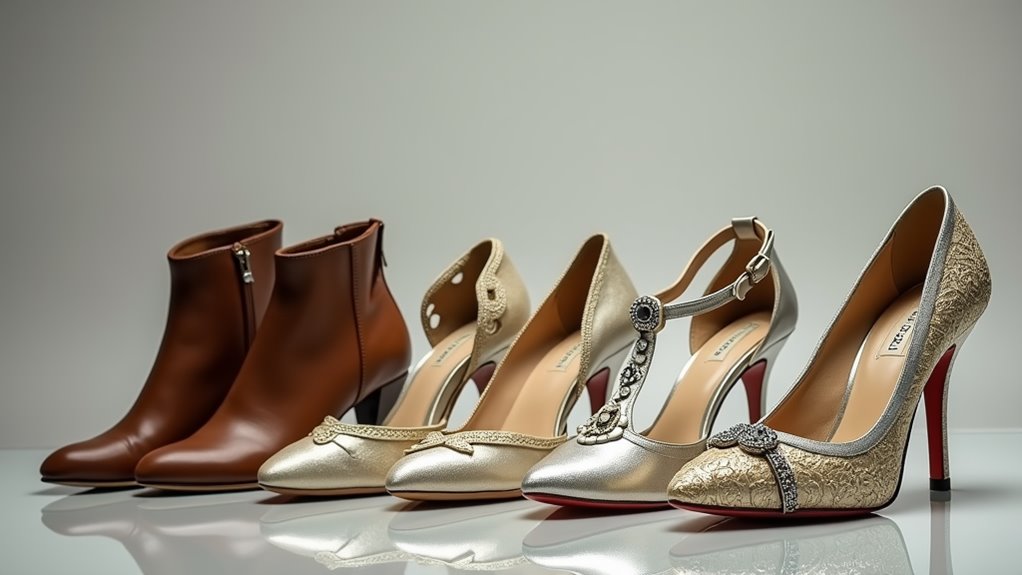
Throughout the 1920s, the fashion world witnessed a dramatic shift as hemlines rose above the ankles for the first time, transforming shoes from hidden necessities into prominent style statements. We can trace this evolution as designers began responding to the newfound visibility of footwear, creating innovative styles that demanded attention rather than concealment.
As we examine the popular styles that emerged during this period, we’ll find that pumps with modest 2-inch heels became a staple, alongside practical slip-ons and Oxfords. These fashion choices reflected the era’s perfect balance between style and functionality. The shoes’ designs evolved significantly, starting with pointed toes that later gave way to almond and square shapes, demonstrating the decade’s changing aesthetic preferences.
We’re particularly intrigued by how the introduction of ready-to-wear shoes democratized fashion during this period. No longer did women need to rely on custom-fitted footwear; instead, they could easily access the latest styles. This accessibility, combined with the increased visibility of shoes in everyday fashion, created a new focus on footwear as essential fashion accessories rather than mere utilitarian items. The enduring appeal of classic black leather heels emerged during this era, establishing itself as a timeless choice that continues to symbolize elegance today.
Jazz Age Shoe Revolution
As we examine the Jazz Age shoe revolution, we’re struck by how dancing shoes evolved from restrictive Victorian designs to practical Cuban and Louis heels that let women move freely to syncopated rhythms. The emergence of decorative straps and pointed toes marked a dramatic shift toward modern aesthetics, with Mary Jane pumps exemplifying the era’s bold departure from traditional footwear. Evening shoes sparkled with unprecedented glamour, featuring lustrous satins and intricate embellishments that perfectly captured the period’s exuberant spirit while breaking long-held conventions about heel heights and visibility. Today’s formal heel designs continue to honor this revolutionary era while incorporating contemporary materials and styling.
Dancing Shoes Take Flight
The Jazz Age ushered in a footwear revolution that perfectly matched the era’s vibrant dance culture. We’re seeing how shoes were made to accommodate both style and function, as women needed reliable footwear for energetic dances like the Charleston. The transition from Louis heels to Cuban heels wasn’t just about height – it was about creating the perfect balance for dancing.
| Style Feature | Day Wear | Evening Wear |
|---|---|---|
| Heel Type | Louis | Cuban |
| Toe Shape | Pointed | Almond/Square |
| Materials | Leather | Satin |
The evolution of dancing shoes reflected society’s changing needs. Working women could now afford ready-to-wear options that complemented their evening dresses, while maintaining the practicality needed for long nights of dancing. These shoes featured innovative designs with decorative fasteners and high-shine materials, creating the perfect blend of glamour and functionality. The heel height and shape were carefully considered, ensuring women could move freely while maintaining elegance. This marked a significant shift from purely decorative footwear to shoes that served both fashion and function, becoming an essential element of 1920s social life.
Straps, Sparkles, and Shine
Dancing wasn’t the only revolution sweeping through 1920s footwear – glamour took center stage with an explosion of decorative elements that defined the era’s most striking shoes. We can see how the transition from purely functional designs gave way to stunning evening footwear that captured the spirit of the Jazz Age, with high heels leading this dramatic transformation.
The introduction of straps became a defining feature, as T-strap designs and open-toe styles complemented the shorter hemlines that were taking over fashion. These new designs weren’t just about function – they showcased the foot in ways that previous decades hadn’t dared. Patent leather and satin emerged as the materials of choice, adding a brilliant shine that caught the light in jazz clubs and dance halls.
What truly set these shoes apart was their bold embrace of embellishment. We’re talking about shoes adorned with sequins, sparkles, and decorative details that turned every step into a statement. The addition of ankle straps and unique fasteners allowed women to express their individuality, while vibrant reds and metallics replaced the subdued tones of previous eras.
Heel Heights Break Tradition
Breaking with centuries of tradition, heel heights in the 1920s underwent a dramatic transformation that reflected women’s changing roles in society. We can trace this revolution in womens fashion through the emergence of more practical, yet equally stylish footwear options that defined the decade.
The shift toward 2-inch pumps marked a significant departure from the towering heels of previous eras. These new popular shoe styles weren’t just about comfort – they represented a broader cultural change as women embraced more active lifestyles. The introduction of Louis and Cuban heels offered the perfect balance between elegance and functionality, allowing women to dance, work, and move freely while maintaining their fashion-forward appearance.
This transformation in heel heights coincided with rising hemlines, creating a fascinating interplay between shoe design and dress length. As shoes became more visible, manufacturers responded with innovative designs that emphasized both form and function. Evening shoes maintained their glamorous appeal through high-shine materials and decorative elements, but even these special occasion styles reflected the era’s preference for more manageable heights that supported the dynamic lifestyle of the modern 1920s woman.
Materials and Manufacturing Changes
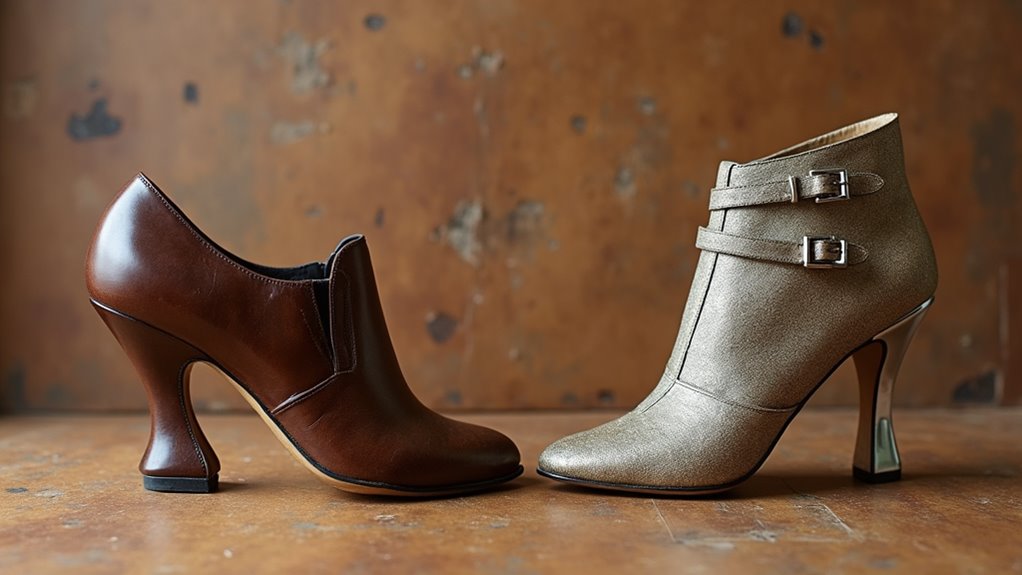
During the roaring twenties, revolutionary changes in materials and manufacturing techniques transformed the shoe industry, particularly in heel production. We saw leather remain the dominant material, while shoe designers embraced new options like rayon, which provided an affordable alternative to silk. The integration of exotic skins, including alligator and python, became increasingly popular for evening footwear.
| Material Type | Primary Uses |
|---|---|
| Rayon | Everyday shoes |
| Leather | Standard footwear |
| Exotic skins | Evening wear |
Mass production techniques revolutionized how we made shoes, introducing assembly lines and machine stitching that dramatically improved production efficiency. These advancements allowed manufacturers to create consistent, high-quality footwear at unprecedented speeds. The combination of new materials and manufacturing processes sparked experimentation with glossy finishes and decorative elements, particularly in heel design. We witnessed cobbler’s tools evolve from primarily hand-worked implements to more sophisticated machinery, enabling precise stitching and faster assembly. These innovations democratized fashion, making stylish heels accessible to more women than ever before, while maintaining the quality standards that had previously been achievable only through time-consuming handcrafting methods.
Popular Heel Styles
The 1920s ushered in bold changes to heel styles, marking a significant shift from the Victorian era’s restrictive designs. We can trace this evolution through the decade, beginning with the sturdy Louis heels that dominated early footwear. These practical heels later transformed into the more sophisticated Cuban style, which became a staple of formal wear throughout the period.
The progression didn’t stop at heel types. We’ve seen how early 1920s designs featured distinctly pointed toes, but by mid-decade, these evolved into softer almond shapes and practical square alternatives. Evening shoes took on particularly dramatic features, with high shins and ornate heels often crafted in black patent leather or lustrous satin. The introduction of T-straps and lattice designs revolutionized how women’s shoes fit and functioned.
What’s particularly fascinating is how decorative elements enhanced these heel styles. We can observe the innovative use of gems and sequins as fasteners, making fashionable footwear more accessible to the average woman. These embellishments, combined with varying heel heights and strap configurations, created unprecedented versatility in women’s high heels during this transformative decade. Many of these intricate designs continue to inspire modern detailed wedding heels that elevate bridal fashion.
Evening Wear Glamour
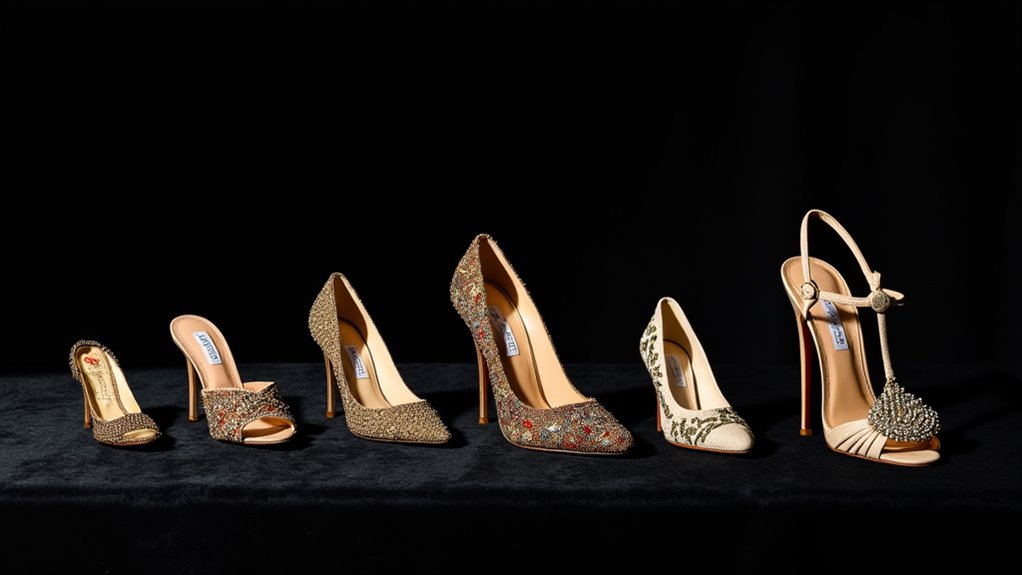
When we look at 1920s evening shoes, we’re immediately drawn to the rise of embellished satin dance shoes that featured gleaming sequins, intricate beadwork, and lustrous finishes perfect for social gatherings. Art Deco influences brought geometric patterns and glittering embellishments to high-heeled evening footwear, transforming basic shoes into statement pieces that commanded attention at parties and dance halls. These glamorous evening styles, typically featuring modest 2-inch heels, allowed women to move gracefully while expressing their social status through sophisticated designs that perfectly complemented their fashionable headwear and evening attire. These exquisite party shoes became sought-after vintage collectibles that continue to inspire modern fashion designers.
Embellished Satin Dance Shoes
Glittering across dimly lit dance floors, embellished satin dance shoes captured the essence of 1920s evening glamour. We’ve discovered that these shoes weren’t just accessories; they were statements of sophistication that defined the era’s social gatherings and jazz parties.
| Feature | Function |
|---|---|
| Satin Material | Luxurious sheen complementing flapper dresses |
| Embellishments | Sequins, beads, and embroidery for visual appeal |
| Heel Heights | Varied stiletto options for grace and stature |
| Comfort Elements | Padded insoles and ankle straps for support |
The evolution of evening wear during this period showcases how embellished satin became the preferred choice for dance footwear. We can trace how these shoes transformed from simple dancing slippers to more elaborate designs, incorporating stiletto heels in the late 1920s. The attention to both style and functionality demonstrates the era’s commitment to combining glamour with practicality.
What’s particularly noteworthy is how these shoes were engineered for comfort during long nights of dancing while maintaining their decorative appeal. The designers’ thoughtful inclusion of supportive features ensured that women could dance the night away without sacrificing style for comfort.
Glittering Art Deco Heels
Inspired by revolutionary Art Deco aesthetics, evening heels of the 1920s underwent a dramatic transformation into dazzling works of wearable art. We can see how these glittering masterpieces incorporated geometric patterns and bold design elements that perfectly captured the era’s pursuit of modernity and sophistication.
The high-heeled pumps of this period weren’t merely functional footwear – they were statement pieces adorned with intricate embellishments. We’re drawn to the meticulous detail work: hand-painted motifs, shimmering beadwork, and metallic accents that complemented the era’s iconic flapper dresses. The craftsmanship reached new heights as designers experimented with luxurious materials like satin and gleaming leather.
The introduction of the T-strap design marked a significant evolution in evening wear, offering both stability and style. We’ve discovered that these shoes often featured ankle straps, which provided essential support while creating an elegant silhouette. What’s particularly fascinating is how designers incorporated Art Deco’s signature elements – from bold geometric shapes to innovative decorative techniques – transforming everyday footwear into evening masterpieces that defined the decade’s formal fashion landscape.
Decorative Elements and Embellishments
Throughout the 1920s, shoe designers transformed everyday footwear into stunning works of art through an array of decorative elements and embellishments. We’ve discovered that decorative fasteners, including gems and sequins, made fashionable footwear more accessible while adding glamorous touches that defined the decade’s style.
- Ornamental heels featured high-shine finishes and satin materials
- T-straps and lattice designs offered both style and improved fit
- Hand-painted details incorporated artistic motifs and patterns
The era’s creativity really shines through in the unique patterns and contrasting leather combinations that adorned these shoes. We can see how designers cleverly used various materials to create visual interest, often combining different textures and colors in ways that hadn’t been seen before. The popularity of evening shoes particularly showcases this trend, with their emphasis on high sheen and ornamental heels that captured the decade’s love for glamour. What’s fascinating is how these decorative elements weren’t just beautiful – they were functional too. The strappy styles that emerged provided better fit and comfort while still maintaining the elegant aesthetic that we associate with 1920s footwear. The glossy red finish became particularly sought-after for special occasions, adding a bold and sophisticated touch to formal attire.
Color Trends and Patterns
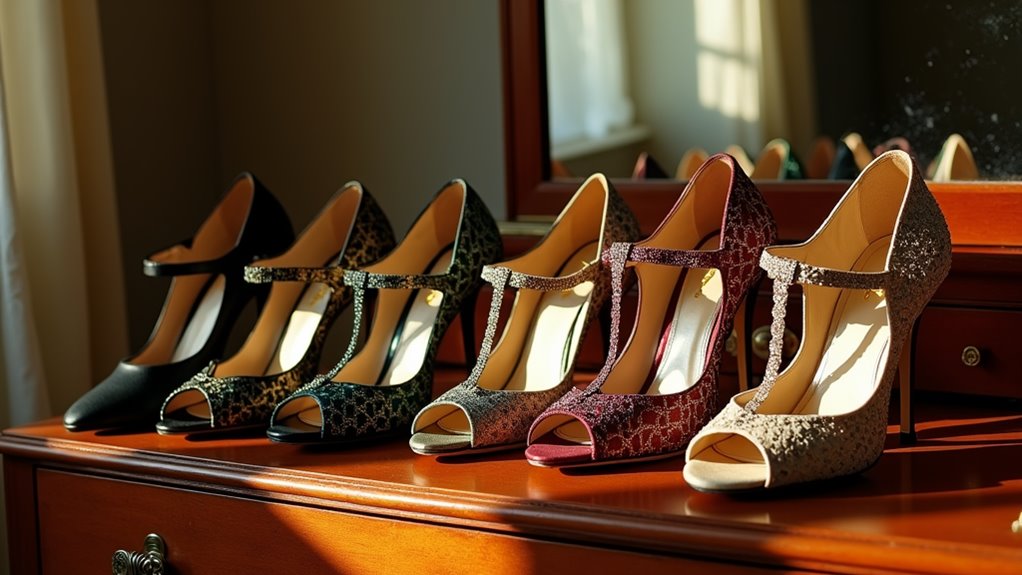
The color palette of 1920s footwear reflected the era’s distinct fashion sensibilities, with a clear division between daytime and evening styles. During daylight hours, we saw shoes predominantly in understated shades of black, brown, grey, and beige, which aligned with the practical needs of daily wear while maintaining sophistication.
Evening footwear, however, took a dramatically different approach. We can observe how these designs embraced vibrant colors and high-gloss finishes, creating striking visual statements that captured the decade’s glamorous nightlife. The introduction of strappy designs, particularly T-straps and lattice pumps, provided the perfect canvas for experimenting with bold colors and intricate patterns.
What’s particularly fascinating is how shoe designers achieved visual interest through contrasting leather combinations. These innovative patterns weren’t just decorative; they revolutionized footwear aesthetics. The addition of gems and sequins as fasteners further enhanced these designs, making fashionable footwear more accessible to the average consumer. We can see how these color and pattern choices weren’t arbitrary but instead reflected the broader cultural shift toward more expressive and diverse fashion statements in the 1920s.
Social Impact of Heel Fashion
Social transformation in 1920s America found a powerful symbol in women’s heel fashion, as shorter hemlines finally allowed footwear to take center stage in daily attire. We can see how heels became more than just accessories – they made powerful statements about women’s changing roles in society. As the “New Woman” emerged, wearing trousers and embracing modern fashions, heels became popular symbols of independence and self-expression.
- T-strap heels reflected the era’s dance culture and need for practical yet stylish footwear
- Decorative embellishments symbolized women’s newfound freedom to express themselves
- High heels became associated with the flapper movement’s challenge to traditional norms
The social impact of 1920s heel fashion went far beyond mere style. We’re witnessing a period when footwear helped redefine femininity and independence. Dance halls filled with women wearing comfortable yet fashionable heels, enabling them to participate fully in the decade’s vibrant social scene. The transformation of heels from purely functional items to statements of personal identity marked a significant shift in how society viewed women’s fashion and their role in public life.
Comfort Meets Style Movement
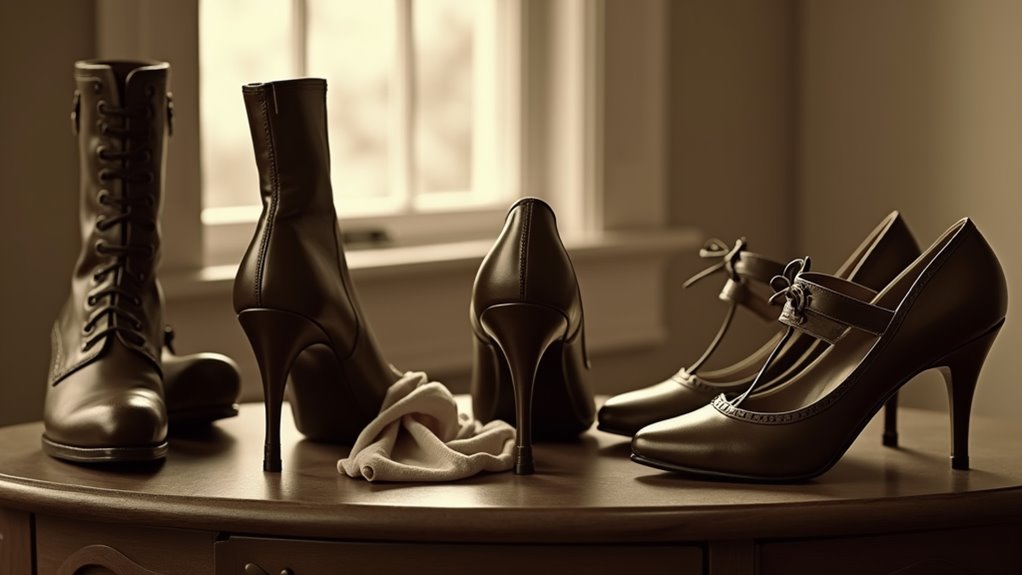
During the post-war era of the 1920s, women’s footwear underwent a revolutionary transformation as comfort and style merged into a unified movement. We can see how the shoe industry responded to women’s changing lifestyles by introducing lower, more manageable heel heights that provided greater freedom of movement while maintaining fashionable appeal.
The comfort meets style revolution brought significant innovations to women’s footwear design. Manufacturers began incorporating practical features like sturdy straps and cushioned footbeds into their daywear shoes, allowing women to move freely throughout their daily activities. The introduction of Louis and Cuban heels offered the perfect balance of stability and elegance, catering to the active “New Woman” of the era.
Perhaps most notably, versatile designs like the Mary Jane pump emerged as a perfect synthesis of comfort and fashion. These adaptable shoes proved ideal for various social occasions while ensuring wearers remained comfortable. The movement’s influence extended to materials as well, with designers experimenting with suede and exotic skins that enhanced both the tactile comfort and visual sophistication of women’s shoes. Today’s fashion continues this legacy of combining style with sustainability through eco-friendly non-leather alternatives that honor both aesthetics and environmental consciousness.
Conclusion
As we’ve tracked the journey of 1920s heels from practical footwear to statement pieces, we’ve seen how form truly followed function. Like a butterfly emerging from its chrysalis, heels transformed from simple leather walking shoes into dazzling works of art. We’ve watched manufacturing advances, social changes, and the Jazz Age’s influence reshape women’s footwear into the glamorous yet comfortable styles we still reference today.

